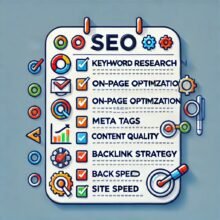Three Basic Steps to Search Engine Optimization
Introduction
Search Engine Optimization (SEO) is pivotal in ensuring a website’s visibility in search engines.
With billions of websites online, businesses must understand and apply SEO techniques effectively to stand out.
This article focuses on the Three Basic Steps to SEO: On-page, off-page, and technical SEO. It offers a comprehensive guide for beginners and experienced marketers.
Understanding SEO Fundamentals
What is SEO?

SEO is the process of optimizing a website to rank higher in search engine results, making it easier for users to find relevant information.
It includes strategies that align with search engine algorithms to increase visibility organically.
Why SEO Matters
SEO drives organic traffic, enhances brand credibility, and reduces dependency on paid advertising. A well-optimized website ensures a better user experience and long-term growth.
Step 1 – On-Page Optimization
Keyword Research
Keyword research is the foundation of on-page SEO.
It involves identifying potential customers’ search terms and naturally integrating them into content.
Content Optimization
Creating valuable content with targeted keywords improves user engagement and search engine rankings. High-quality, original content helps attract more traffic and leads.
Meta Tags and Headings
Proper use of meta tags (title tags, meta descriptions) and headings (H1, H2, H3) enhances search engine crawling and provides structure to content.
URL Structure
SEO-friendly URLs are concise and descriptive, giving search engines and users clarity about the page’s topic.
Internal Linking Strategy
Internal links help users navigate the site and distribute page authority across the website, improving search rankings.
Step 2 – Off-Page Optimization
Backlink Building
Acquiring backlinks from authoritative websites signals to search engines that your content is trustworthy and valuable.
Social Signals
Social media activity can indirectly boost SEO by increasing content visibility and driving more traffic to the website.
Online Reputation Management
Maintaining a positive online reputation is essential for SEO success, as search engines consider brand sentiment when ranking pages.
Step 3 – Technical SEO
Site Speed Optimization
Faster-loading websites offer a better user experience and are more likely to rank higher on search engines.
Mobile-Friendliness
With the rise in mobile browsing, ensuring a site is mobile-responsive is critical for SEO.
Sitemap and Indexing
Submitting a sitemap to search engines ensures all essential pages are indexed correctly and quickly.
Structured Data Markup
Using structured data (schema) helps search engines understand the content better, improving search visibility.
Measuring SEO Success
SEO Analytics Tools
Tools like Google Analytics and Google Search Console allow website owners to monitor traffic, user behavior, and overall performance.
Key Metrics to Monitor
Tracking metrics like organic traffic, bounce rate, and conversions helps assess the effectiveness of SEO efforts.
Common SEO Challenges and Solutions
Algorithm Updates
Search engines frequently update their algorithms. Staying informed ensures your site complies with the latest standards.
SEO vs. Paid Advertising
While both SEO and PPC (pay-per-click) have their benefits, SEO offers long-term value and builds trust with users.
FAQs
- What are the most important SEO factors?
Content, backlinks, and technical SEO are key factors. - How long does SEO take to show results?
SEO efforts can take 3-6 months to reflect significant changes. - Can SEO be done without technical knowledge?
Basic SEO can be implemented without advanced skills, but technical expertise enhances results. - What is the role of content in SEO?
High-quality content helps attract organic traffic and improves rankings. - How important are backlinks?
Backlinks are essential for off-page SEO, signaling content credibility. - Can SEO guarantee top rankings?
No. SEO improves visibility, but rankings depend on various factors beyond optimization.
Conclusion
Recap of the Three Steps to SEO Success
Mastering on-page, off-page, and technical SEO is crucial for achieving higher search engine rankings.
Final Thoughts
SEO is a continuous process. Staying updated with trends and algorithm changes ensures long-term success in the competitive online landscape.
=======================================
SEO Trends: What You Need to Know in 2024
Search Engine Optimization (SEO) evolves every year, and staying on top of current trends is critical for maintaining visibility.
As search engines like Google update their algorithms, businesses must adapt their strategies to remain competitive. Below are the top SEO trends for 2024 that will shape how websites rank in search results.
1. AI-Powered SEO Strategies
AI is reshaping SEO by offering smarter tools for optimization:
- Content creation tools such as ChatGPT assist in producing SEO-optimized text.
- AI-based keyword research tools predict search trends better than ever before.
- Google’s RankBrain and BERT algorithms focus on user intent, not just keywords.
2. Voice Search Optimization
With the popularity of smart speakers (like Alexa and Google Home), optimizing for voice search is crucial:
- Focus on conversational queries and long-tail keywords.
- Structure content to answer common questions concisely.
- Include FAQs to align with natural language search patterns.
3. Core Web Vitals as a Ranking Factor
Google’s Core Web Vitals continue to influence rankings. These metrics assess:
- Loading time (Largest Contentful Paint – LCP).
- Interactivity (First Input Delay – FID).
- Visual stability (Cumulative Layout Shift – CLS).
Fast, responsive websites provide a better user experience and rank higher in search results.
4. Mobile-First Indexing
Google now prioritizes the mobile version of websites for indexing and ranking. Ensure:
- Responsive design for a seamless experience across devices.
- Optimize page speed for mobile users.
- Test usability with Google’s Mobile-Friendly Test Tool.
5. E-A-T (Experience, Expertise, Authority, Trustworthiness)
Building E-A-T is essential for higher rankings. Google evaluates:
- The credibility of content and its authors.
- User-generated reviews and ratings across the web.
- External links from authoritative websites as validation.
6. Visual Search Optimization
Visual search tools like Google Lens are changing how users find products and information:
- Image optimization is key (use descriptive alt texts and high-quality images).
- Leverage structured data to enhance visibility.
- Optimize for Pinterest SEO to reach users via image search.
7. Content Quality and Topical Authority
Google now favors content that demonstrates topical depth rather than isolated keywords:
- Cover multiple angles of a topic within a post.
- Build content clusters to strengthen topical relevance.
- Update older content regularly to maintain freshness.
8. Video SEO and YouTube Optimization
Videos are becoming more critical for SEO success:
- Optimize video titles, descriptions, and tags for SEO keywords.
- Create transcripts for accessibility and better ranking.
- Promote videos on YouTube to leverage its search engine power.
9. Local SEO and Google Business Profile Optimization
For businesses targeting local customers:
- Keep your Google Business Profile (GBP) updated with accurate information.
- Gather and manage customer reviews to enhance local rankings.
- Use local keywords in content and meta tags.
10. User Intent and Search Behavior Analysis
Modern SEO focuses on understanding user intent:
- Create content for navigational, informational, and transactional searches.
- Use tools like Google Trends to monitor user behavior shifts.
- Focus on satisfying search intent rather than keyword density.
11. Zero-Click Searches and Featured Snippets
More searches now result in zero-click outcomes where users find answers on Google’s results page:
- Optimize content for featured snippets.
- Use structured data markup to increase the chance of snippet placement.
- Provide concise answers within the first few lines of content.
12. Privacy-Focused SEO
With increased focus on privacy, Google’s move to phase out third-party cookies will impact SEO:
- Focus on first-party data collection.
- Build email lists and loyal communities to mitigate data restrictions.
- Adapt to Google Analytics 4 for privacy-compliant tracking.
13. Personalized Search Results
Google continues to tailor search results based on user behavior:
- Offer customized content based on audience segments.
- Encourage repeat visits by creating user profiles.
- Use retargeting strategies to engage returning users.
14. Structured Data for Better Search Visibility
Using structured data (schema markup) helps search engines understand your content:
- Implement schema for events, products, reviews, and FAQs.
- Structured data improves eligibility for rich snippets.
- It enhances click-through rates (CTR) by offering more information upfront.
15. Sustainable SEO Practices
Environmental sustainability is now influencing consumer behavior and SEO:
- Optimize websites to reduce carbon footprint (e.g., lightweight code).
- Promote eco-friendly business practices within content.
- Align with the growing trend of green marketing.
FAQs
- What is the most significant SEO trend for 2024?
AI-powered SEO tools and content creation are the most transformative trends this year. - How can I optimize for voice search?
Use conversational keywords, focus on question-based content, and create FAQs. - What is Core Web Vitals?
Core Web Vitals are Google metrics measuring page speed, interactivity, and visual stability. - Is video SEO worth the effort?
Optimizing videos can significantly improve engagement and rankings, especially on YouTube. - How do I stay updated on SEO trends?
Follow industry leaders, attend webinars, and review Google’s algorithm updates regularly. - Can SEO help my local business?
Absolutely! Local SEO helps businesses attract nearby customers and build community trust.
Conclusion
SEO is constantly evolving, and staying updated on trends ensures your website remains competitive in search engine results.
From AI-powered strategies to privacy-focused practices, adapting to new trends will keep your site ahead of the curve.
Remember, SEO is a long-term investment that requires continuous effort and learning.





